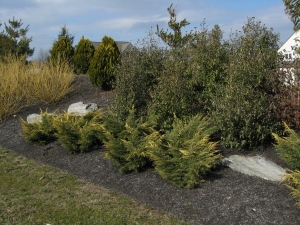This March the weather has certainly seen its ups and downs. Up to 70s and down to 20s. Rain, snow and 50 mph winds. If I worked in an office, I wouldn’t care so much, or probably even really notice, but I don’t. The changes in the weather, often very abrupt, have caused me to pause in my gardening endeavors, and carry plants that were out, back in again at night lest they be nipped by Jack Frost. Let’s hope April cuts us a break.
For those of you wanting to get a jump on the vegetable garden, peas, onions, and seed potatoes, can and should be in now or very soon. Lettuces, spinach and kale, and the cole crops like broccoli, cauliflower and cabbage can also go in now. Keep one eye on the weather and several buckets or row covers handy to protect young plants. Cauliflower and lettuces are sensitive to frost damage, especially when young.
In this area we always get a better fall harvest from Brussels sprouts, broccoli and cabbage than we do in the spring, but that doesn’t usually stop me from planting them anyway. They tend to bolt- or send up flower stalks in June as soon as it gets hot, so shorter season varieties that produce heads quickly are the best choice.
Asparagus and strawberries are perennial crops and can go in now as well.
For asparagus, let the plants establish the first year, the second year you can begin to harvest the emerging spears. Its ferny, exotic foliage looks especially handsome along the border of the garden.
Strawberries come in two forms- June-bearing and ever-bearing. If you are looking to make jam, the June-bearing kinds are what you want. You will get a large harvest all at once from late May to mid-June depending on the weather. The first year, snip the blossoms to allow the plants to concentrate on growing and establishing a good row. The second year, get your Mason jars ready.
Ever-bearing strawberries are just what they sound like. Expect a few handfuls throughout the summer. The flavor on these is also getting better. Snip the blossoms until June the first year, and then let them make some fruit. Several ornamental varieties are on the market with pink or red flowers that make nice additions to hanging baskets or patio containers.
There are some crops that are best planted from seeds rather than young transplants. I’m thinking specifically of beets, corn and beans. These can all go in the ground in mid-late April. Short rows of corn planted several weeks apart will give you a succession of harvest throughout the summer.
Our advice about tomatoes is to check the weather around April 20th. If the 10-day weather forecast is above 40 at night, go for it. If not, wait another week or so.
Don’t even think about peppers, cucumbers, melons or squash until after frost in mid-May. They need warm soil, and warm nights and will thank you for waiting.
Currently we are fighting a rabbit that perches on a retaining wall and nibbles off the strawberries. Before I plant my broccoli and lettuces I need to invest in some chicken wire fencing or all my efforts will be for naught. The dogs sleep in the house at night and are not earning their keep. Maybe I need to borrow a cat from my sister-in-law.
 Perennial gardening can be overwhelming. With thousands of choices of sun and shade perennials, making a decision is difficult for the novice and expert gardener alike. The Perennial Plant Association, a group of landscapers, growers, and other perennial afficianados aims to help by naming one special plant each year to feature. The association started selecting Perennial Plants of the Year in 1990. These 26 plants are tried-and-true, fantastic perennials for a variety of conditions. If you need a place to start, this list is a gold-mine.
Perennial gardening can be overwhelming. With thousands of choices of sun and shade perennials, making a decision is difficult for the novice and expert gardener alike. The Perennial Plant Association, a group of landscapers, growers, and other perennial afficianados aims to help by naming one special plant each year to feature. The association started selecting Perennial Plants of the Year in 1990. These 26 plants are tried-and-true, fantastic perennials for a variety of conditions. If you need a place to start, this list is a gold-mine.

